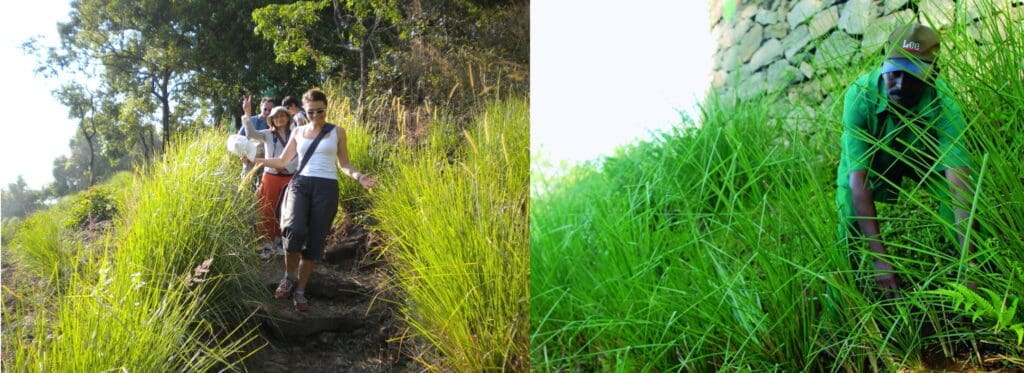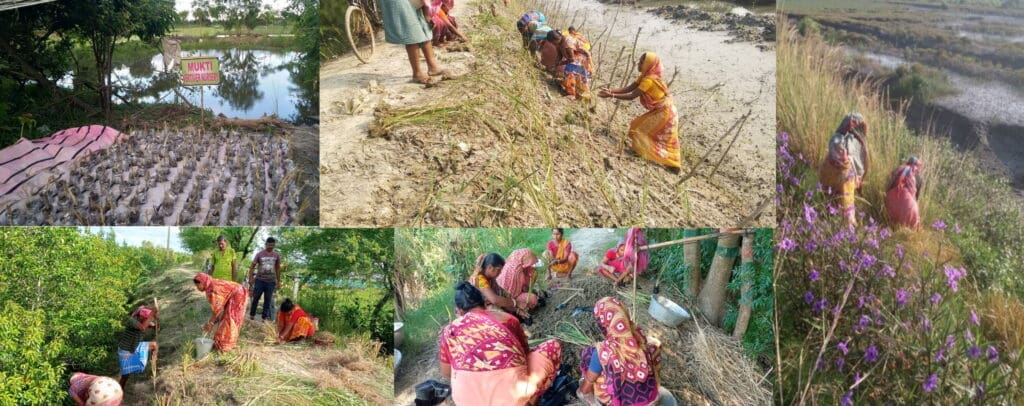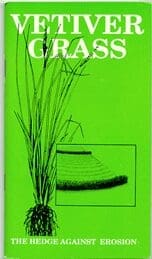A 15-Year-Old Case Study Of How Low-Cost Vetiver Grass Technology Can Turn A Fragile Landscape Into A Resilient, Income-Generating Asset.
In 2011, at the 5th International Vetiver Conference in Lucknow, India, Mr. Abdul Samad and P Haridas were awarded a First Prize in the area of VS dissemination for the presentation on their work with Vetiver at the Blackberry Hills Nature Resorts in Munnar, Kerala, India. Paul Troung, TVNI’s Technical Director, visited there in 2008 and was impressed with their work; he made a presentation to showcase their work. Recently, Mr. Abdul Samad posted a link to the Blackberry Hills Nature Resort to the AW#Vetiver Whatsapp group. It is gratifying to see how their work since 2008 has matured; providing a showcase of how low-cost Vetiver Grass Technology can turn a fragile landscape into a resilient, income-generating asset.

When Mr. Samad and a group of his friends bought the Blackberry Hills estate in 2004, one-third of the top-soil had already been lost to erosion. As conventional engineering fixes were unaffordable, he followed the advice of one of India’s most well-known and experienced Vetiver experts, Mr. P. Haridas, and started out with planting 2,000 slips of vetiver across steep slopes. Within a year dense hedgerows—spaced roughly two meters apart on the contour—had stitched the hillside together, inaugurating what Mr. Samad has christened “Zero-Risk Slope Farming.”
Over the next decade-and-a-half the resort used vetiver everywhere: stabilizing cottage platforms, anchoring buried pipelines, edging forest paths and even thatching a visitor hut. Leaves are cut three-times a year for mulch, reducing irrigation demand and reportedly repelling caterpillars; the switch enabled organic strawberries, carrots and cabbage that now meet some of the kitchen’s annual needs. More than 40 farmhands have been trained in vetiver propagation and are now earning income by executing slope-protection works on neighboring smallholdings—an unexpected livelihood boost, especially for local women who have been hired for tiller preparation and nursery care.
Blackberry Hills actively shares its “living classroom.” Guests receive a vetiver briefing; panchayat members and tea-plantation managers are invited for field days; and the resort helped launch the India Vetiver Network, with Samad serving as founding treasurer. Their website markets vetiver as part of its eco-credentials—proof that soil-saving bio-engineering can also underpin a successful tourism brand. For hill stations worldwide grappling with climate-change-driven extreme rainfalls and landslips, Blackberry Hills offers a highly instructive, 15-year case study from which to learn.
Mukti’s Vetiver Bio-shields: Community-Powered Resilience in the Sundarbans
On the cyclone-scarred mud embankments of India’s Sundarbans, the grassroots NGO Mukti is rewriting the disaster-risk-reduction playbook with an elegant ally: vetiver grass (Chrysopogon zizanioides ). In 2021 the organization’s women-led self-help groups began planting vetiver along eroding village bunds. The first planting of about 3,350 clumps took root within a few week and began stabilizing these vulnerable clay banks, and the dense hedges that formed captured silt and reduced the energy of the waves running up the berm.
Encouraged by the rapid greening and zero plant losses during the ensuing monsoon, Mukti scaled the idea into the Mukti Green Defence System (MGDS): a three-tier “living shield” that couples vetiver with salt-tolerant mangroves for long-term protection, and income-generating crops such as dragon-fruit, on the landward side of the berms. The flagship MGDS programme, launched in 2024, aims to armor 24 km of embankments across Nagendrapur and Kankandighi Gram Panchayats—home to some 40,000 people—against storm-surge breaches. (See video, here)
Among the things that make Mukti special is its community-based approach. Local women propagate slips in micro-nurseries, earning fair wages while honing nursery skills; schoolchildren track bank-height changes for citizen-science learning; village Panchayats donate labor for planting drives; and private Corporate Social Responsibility (CSR) partners underwrite basic capital requirements (e.g., purchase of tools, compost, others). This shared-ownership model has kept survival rates high (above 90 % after two seasons) and maintenance costs low, proving that nature-based solutions succeed when they rest on a foundation of an active community’s social capital.

Key lessons:
- Start small, learn fast: A pilot strip under real surge conditions builds local evidence and trust before full-scale roll-out.
- Layer defences: Vetiver hedges excel at immediate toe reinforcement but pairing them with slower-growing mangroves delivers a stronger, multi-functional barrier.
- Women at the core: SHG nurseries create livelihoods, ensure year-round care, and unlock finance streams that pure “conservation” projects often miss.
- Measure what matters: Simple community monitoring of slip survival, bank recession and saline intrusion keeps funders engaged and allows on-the-fly design tweaks.
- Tell the story: Video reels, school rallies and photo blogs turn a grass hedge into a symbol of hope—vital for mobilizing fresh villages and donors.
From fragile mud to living levees, Mukti’s vetiver experiences show how a simple grass—backed by an empowered community—can turn the tide for climate-exposed delta dwellers everywhere. To learn more about Mukti’s work with vetiver grass, see this link.
How hard can it be? A case of “self-teaching”
Here at TVNI we see the Vetiver System as a practical and affordable package (or “toolkit”) that rural households/communities can manage themselves. The multipurpose VS toolkit offers some thirty different eco-engineering applications for climate-smart/regenerative agriculture, soil health, protecting/conserving/restoring water resources, stabilizing and protecting infrastructure and watersheds, decontaminating land and water, preventing natural disasters and mitigating natural disaster risks, and enhancing livelihoods (e.g., fodder, handicrafts, roofing thatch, essential oil, medicines, carbon sequestration). Critically, this toolkit does not require large government extension services or costly public programs to get into the hands of farmers and communities for them to use. While support from governments to extend and scale-up the use of the VS could go a long way toward achieving landscape-scale impacts – e.g., enabling policies, information dissemination and capacity building, propagation and distribution of planting materials for household/community nurseries, etc. – in the absence of such support (the norm throughout most Vetiver-using countries), because the technology itself is simple and readily understandable, there is tremendous potential for grassroots efforts and farmer-to-farmer learning to scale up the use of VS.
With these thoughts in mind, I recently encountered in the WOCAT (World Overview of Conservation Approaches and Technologies) database a publication from 2007, entitled “where the land is greener – case studies and analysis of soil and water conservation initiatives worldwide”. The publication contains a case study from South Africa, where vetiver grass hedges were planted in sugar cane fields, and along stream banks and roadsides. on a commercial farm (owned by Maxime Robert) in Kwa-Zulu Natal Province.
 What attracted me to this article was WOCAT’s “surprise” at finding that “A technical system devised from a handbook and experience rather than needing a project or intensive visits from extension agents” could lead to successful adoption. They were referring to the fact that Maxime Roberts learned how to apply VGT using “The Little Green Book” (originally published by the World Bank), thus representing a case of “self-teaching.” That is, adoption was triggered not by government extension staff but by the farmer reaching out and getting a copy of the handbook through the mail. Following the instructions in the handbook, he experimented, refined spacing for his conditions, and even hosted informal field visits amongst neighboring farmers. The case study concludes that “The approach demonstrates that well-packaged written material (now also in Zulu) plus farmer-to-farmer observation can disseminate vetiver technology at negligible public cost”. This particular strength of the VS, the potential to go to scale “at negligible public cost” is unique. It also explains why some 40 years on, the VS has expanded to the extent that it has, around the globe, based primarily upon grassroots efforts.
What attracted me to this article was WOCAT’s “surprise” at finding that “A technical system devised from a handbook and experience rather than needing a project or intensive visits from extension agents” could lead to successful adoption. They were referring to the fact that Maxime Roberts learned how to apply VGT using “The Little Green Book” (originally published by the World Bank), thus representing a case of “self-teaching.” That is, adoption was triggered not by government extension staff but by the farmer reaching out and getting a copy of the handbook through the mail. Following the instructions in the handbook, he experimented, refined spacing for his conditions, and even hosted informal field visits amongst neighboring farmers. The case study concludes that “The approach demonstrates that well-packaged written material (now also in Zulu) plus farmer-to-farmer observation can disseminate vetiver technology at negligible public cost”. This particular strength of the VS, the potential to go to scale “at negligible public cost” is unique. It also explains why some 40 years on, the VS has expanded to the extent that it has, around the globe, based primarily upon grassroots efforts.
If you would like to read more about Maxime Roberts and other early adopters and promoters of VGT in Africa, here is a 1990s trip report from Dick Grimshaw “A visit to Southern Africa” that still makes good reading today. Also, you can download the “Little Green Book” here. It is also available in a number of other languages on our website: French (for Haiti), Chichewa (Malawi), Bengali, French, Indonesian, Spanish, Swahili, and Vietnamese.
Editor’s note: If you read the WOCAT publication, it contains some inaccuracies or potentially misleading information. Note to WOCAT:
- According to the case study “single lines are used, though double lines are generally recommended for more effective hedge creation”. No, double lines are not generally recommended.
- It is noted that cutting the hedges back before the dry season is important in order to prevent burning. If the purpose is to reduce fuel loading in the field during the fire season, fine. Otherwise, burning does not harm vetiver and is often used to “renew” the hedge. Indeed, burning the hedges off at the start of the dry season can provide green fodder for animals into the dry season as the leaves resprout.
- In an editorial comment, WOCAT maintains that vetiver “has often proved unpopular with smallscale farmers, mainly because it does not simultaneously provide fodder for livestock, in contrast to other grass barriers.” This is incorrect. Vetiver grass can (and is) used as a fodder crop, particularly for cattle and goats. Its nutritional value is highest when harvested young, when its crude protein content is comparable to other forage grasses. While its palatability decreases with age, regular cutting ensures a continuous supply of young vetiver leaves, which are readily consumed. It offers a sustainable and resilient feed source, especially in areas prone to drought. You can read more here about Vetiver’s value as a fodder crop, and here about its traditional use as a fodder crop in India.

Community-led Vetiver adoption slashes erosion in Ethiopia’s Somodo watershed
A 2018 field study by Tesfaye et al. in south-western Ethiopia tracked what happens when farmers mobilize themselves to plant vetiver. In just two years the community established more than 45 km of hedgerows—about 20 % of the entire watershed— with dramatic results:
- 36cm of soil built up behind the hedges, physically shortening and flattening the cultivated slope.
- Plots without vetiver lost an estimated 20.9 t ha⁻¹ yr⁻¹ of soil versus plots with vetiver hedges, which effectively trapped that sediment and cut effective slope length/steepness by 13.8%.
- Soil chemistry improved where sediment accumulated: available phosphorus rose while exchangeable acidity fell, pointing to a healthier, more fertile top-layer.
The study underlines three points of special interest to those interested in vetiver:
- Speed of pay-off. Farmers saw measurable terrace formation and fertility gains within two seasons—crucial for sustaining grassroots enthusiasm.
- Landscape impact. Covering one-fifth of the watershed with hedgerows was enough to create a watershed-scale sediment trap, suggesting that strategic placement—not blanket coverage—can still deliver big erosion benefits.
- Social model. Success hinged on community mobilization rather than top-down subsidy: farmers supplied labor and planting material themselves once the technique had been demonstrated, a template that could travel across Africa’s highlands.
For practitioners designing new conservation projects, the Somodo case reinforces how rapidly vetiver hedgerows can translate into tangible soil-and-water dividends, even on steep, heavily worked hillsides. Pairing technical training with collective action may be the fastest route to widespread adoption and healthier soils.
International Center for Environmental Management’s (ICEM) Vetiver Bio-engineering Portfolio: Nature-Based Infrastructure for a Changing Climate
From north-west Viet Nam to Myanmar’s Ayeyarwady Delta, the International Centre for Environmental Management (ICEM) profiles Vetiver grass (Chrysopogon zizanioides) as the “living soil nail” in its green-engineering toolbox. Demonstration sites in Bắc Kạn and Sơn La provinces in Viet Nam found that two simple hedgerows of Vetiver, combined with brush layers, halved river-bank scour during major floods and keep 2:1 roadside slopes intact without concrete.
Early performance monitoring was promising: 90 days after planting, the Vetiver section of the Bắc Kạn test plot had the fastest canopy closure and root tensile strength among four stabilization treatments, despite droughty weather. Similar results are reported in Viet Nam’s Đèo Nhau mountain pass, where community crews inter-planted Vetiver with tiger grass (Thysanolaena latifolia) and low turf species to achieve >80 % soil cover within one monsoon season. ICEM field manuals recommend 15 cm tiller spacing, a pre-monsoon nursery cycle and shallow cut-back pruning to trigger root proliferation; material and labor costs were found to be 30–50 % below masonry frames or gabions on comparable slopes.
Beyond roads, ICEM has tested Vetiver as a hydraulic roughness element on the Ayeyarwady River in Myanmar, pairing grassy toe protection with concrete “porcupine” flow deflectors to slow bank erosion along navigation channels. ICEM’s work clearly demonstrates that vegetative systems, like the Vetiver System, add flexibility to climate-vulnerable assets, contribute to regenerating local biodiversity, and create critical co-benefits, such as contract opportunities for women-led nurseries, paid local employment for work on-site, and through harvesting of the Vetiver grass to use as fodder for livestock in Beyond salaries earned while working on the site, local people also benefitted economically from the bioengineering measures in Son La Province through harvesting the Vetiver grass to use as fodder for livestock.
Some key lessons emerging from ICEM’s work include:
- Design for hydro-variability. Vetiver withstands inundation and prolonged dry spells; coupling it with brush layering or rip-rap protects the toe zone where roots cannot anchor.
- Start small, monitor, scale. 100 m trial segments with quarterly root-pull and shear tests generate the data engineers need to convince road agencies.
- Leverage social capital. In Vietnamese pilot communes, labor cooperatives earned up to USD 1,200/ha establishing nurseries while mastering maintenance skills transferable to other green-infrastructure schemes.
With regional governments now mainstreaming “hybrid” solutions in rural road standards, ICEM’s Vetiver work illustrates how low-cost biomaterials can extend the service life of hard infrastructure under intensifying rainfall and landslide regimes—while putting adaptation budgets back into local hands.
See a short documentary of ICEM’s work.

Vetiver Grass Technology at EGU 2025
The European Geosciences Union (EGU) General Assembly 2025, a premier international conference for earth, planetary, and space scientists, was a showcase for the growing importance of VGT amongst environmental solutions. Four VGT-related presentations were given on topics ranging from mitigating geohazards to large-scale river reclamation and advanced monitoring systems; underscoring the versatility and efficacy of this unique plant. The event was held from April 27th to May 2nd and drew thousands of researchers from around the globe, offering a significant platform for the Vetiver community.
A key presentation, “Field Evaluation of Soil Shear Strength with Vetiver,” was delivered by Avipriyo Chakraborty and Sadik Khan of Jackson State University, USA. Their research highlighted the critical role of Vetiver in enhancing slope stability. Through the use of Electrical Resistivity Imaging (ERI) and novel field-scale direct shear testing, they demonstrated that Vetiver roots can penetrate up to 3 meters, significantly increasing soil shear strength. Their findings revealed that Vetiver not only provides mechanical reinforcement through its dense root system but also reduces soil moisture via evapotranspiration, offering a dual-pronged approach to slope stabilization.
The theme of environmental resilience was further explored in “Nature-Based Solutions for Geohazard Mitigation on Slopes“ by Mohammad Shariful Islam from the Bangladesh University of Engineering and Technology. This presentation positioned Vetiver as a cornerstone of bioengineering strategies for combating erosion and slope instability, issues intensified by climate change. The research showcased Vetiver’s adaptability across diverse and challenging environments, from road embankments to coastal zones, validating its effectiveness as a scalable and cost-efficient nature-based solution.
Expanding the application of Vetiver to a monumental scale, Benito Castorina, Coordinator of the Italian Vetiver Network, presented “The Danube Reclamation Initiative for a Sustainable Mediterranean Future.” This ambitious project, known as “SPES,” aims to tackle pollution in the Danube River, which impacts both the Black Sea and the Mediterranean. The initiative proposes the creation of Sustainable European Pilot Systems (SPES) along the river, utilizing Vetiver grass for biomass filtration and environmental remediation. This forward-thinking project illustrates the potential for Vetiver to be integrated into large-scale, international efforts to restore vital waterways and create sustainable economic opportunities.
Technological innovation in Vetiver applications was the focus of the fourth presentation, “Smart IoT Monitoring System for Nature-Based Slope Stabilization,” by a team led by Apiniti Jotisankasa of Kasetsart University, Thailand. This research detailed the use of Internet of Things (IoT) technology to monitor the performance of Vetiver and other nature-based solutions for slope stabilization in real-time. By tracking key parameters such as soil moisture, pore-water pressure, and slope deformation, the system provides valuable data for assessing the effectiveness of these green infrastructures and for issuing early warnings for potential landslides.
TVNI applauds the work of these researchers and their initiative in participating in EGU 2025, a high visibility platform for promoting the continued growth and recognition of Vetiver as a critical tool in addressing global environmental challenges.

Info vetiver